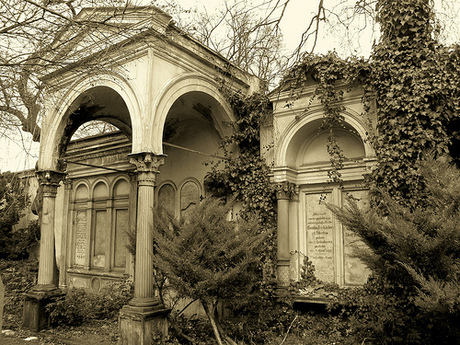Jewish Cemeteries
Established in 1856, The Old Jewish Cemetery is perhaps the most well-preserved testament to the former strength of Breslau’s pre-war Jewish community, with over 1200 gravestones. Closed in 1942, the cemetery quickly fell into deep neglect: in 1945 it was turned into a fortress by the Nazis and saw fierce fighting as evidenced by the eerie bullet holes in many of the gravestones. Preservation began in the 1970s and in 1991 it was opened as the Museum of Jewish Cemetery Art in tribute to the craftsmanship of its sepulchral art. Indeed the beauty and diversity of styles and symbols on display is perhaps unmatched anywhere. Many noteworthy figures are buried here, including the renowned biologist Ferdinand Cohn, the historian Heinrich Graetz (author of the first complete history of the Jews), Clara Immerwahl (first female PhD student at the University of Breslau, wife of Fritz Haber, who committed suicide in objection to her husband’s work developing chemical warfare), Ferdinand Lassalle (founder and leader of the first labour party in Germany, killed in a duel), and the parents of Edith Stein; using old records some of their tombstones are slowly being restored. However, despite these modest efforts the Ślężna Street Cemetery remains a completely mysterious and evocative sanctuary of decaying vine-covered monuments, the broken pieces of which are stacked against each other, giving shelter to stray cats and shade to wildflowers.
Currently, it is estimated that there are 12.000 graves in the Jewish cemetery. Some of them are the tombs of people coming from distant places like Boston, Lubeca, Bonn, Hanover, Gdansk, Warsaw, Tanger (Morocco) for the reason that according to a religious rule the bodies had to be buried on the day of the death or on the next day.
The tombs of the following personalities can be found there:
Ferdinand Lassalle - the founder of the first labour party in Germany
Heinrich Graetz – the author of the ‘’History of the Jews’’
Ferdinand Cohn – a world famous biologist
Gedajle Tiktin – rabbi of the Jewish community, since 1854 the first Royal National Rabbi for the district of Silesia
Auguste and Siegfried Stein – parents of Edith Stein a.k.a. St. Teresa Benedicta of the Cross – a Carmelite nun and convert from Judaism via atheism and
Julius Schottländer - a famous German merchant.
In 1943 the cemetery was closed, however, during World War II wartime activities took place there. Some bullet traces can be found on some of the matzevas nowadays. Though after the war the cemetery began to fall into decay, it was later renovated.Nowadays the cemetery has been a historical monument since 1975.
Admission is 7/5zł and comes with a highly informative booklet which you may choose to either return upon exiting or purchase for 15zł.
The New Cemetery is the fifth largest Jewish cemetery in Poland. It was founded in 1902 when the cemetery at Slezna Street was too small. Since then it has been used by the Jewish Community of Wroclaw. Due to its historical and architectural beauty in 1983 the cemetery was registered as a historical monument. The number of the tombs amounts to approximately 8 thousand. The cemetery is also rich in architecturally varied tombstones and matzevas. The peculiarity is the only ohel (exceptionally dedicated to a woman) to be found in the area of Lower Silesia. There is also a tomb of the Jewish soldiers of the German Army who died during the First World War. Their names (as many as 432) are curved on the top of the monument. Though all the tombs are valuable examples of cemetery architecture, it is hard at times to admire their beauty as lots of the tombs are overgrown with ivy. Nevertheless, walking along the paths with the plants growing wild has an aura of tranquility and mystery.
Located northwest of the centre, the New Jewish Cemetery was founded in 1902 when the Ślężna Street cemetery became too small and is still in use by Wrocław’s Jewish community today. That hasn’t saved it from the ravages of time however, and like the cemetery it succeeded, it stands in sharp contrast to the well-kept Catholic cemeteries across Poland. Comprising 11 hectares and approximately 8,000 graves, this is the fifth largest Jewish cemetery in Poland, and as such carries an even more powerful aura of secret beauty among its maze of ivy-coved headstones and crumbling vaults. Likewise registered as a historical monument for its rich diversity of aesthetic and architectural styles, the most noteworthy tomb here is dedicated to the Jewish soldiers of the German Army who fought and died in WWI; their 432 names are etched into the top of the monument.


